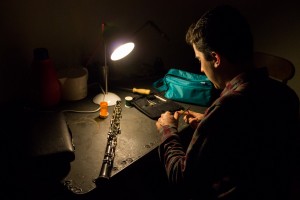It was love at first sound when 12-year-old Will Stevens witnessed a live performance of an oboe solo at a Southern California honors band event.
Just a day after witnessing the oboe solo, Stevens’ teacher coincidentally opened a position in the middle school band for an oboe player. And Stevens has been playing the oboe ever since. The first-year music performance student will be playing with the UCLA Philharmonia on Thursday at 8 p.m. in Schoenberg Hall and Sunday at 6 p.m. at the Los Angeles County Museum of Art.
Stevens said he heard that learning the oboe would be difficult, but he was initially intrigued at the challenge of learning to play the new instrument. His days at UCLA studying the oboe are filled with rehearsal, practice, private lessons and hours of making reeds – devices used to produce sound in the wind instrument.
Stevens’ first lessons were riddled with difficulties, he said. As opposed to instruments like the trumpet, with which players have a wider, rounded mouthpiece to blow through, oboe players channel air through a minuscule opening between two fibers of cane on the reed. The fragile, smaller opening requires the player’s breath be stored and only released in small amounts at a time, initially causing Stevens headaches and many broken reeds.
“Although it was complicated, I just had this weird and inexplicable drive to keep playing this bizarre instrument,” Stevens said. “But I knew I was a weird guy, and I knew it was a weird sound, so it fit me.”
On Tuesday and Thursday afternoons, he attends rehearsal with Philharmonia from 3 to 5:50 p.m.
On the way to one of his Tuesday rehearsals, Stevens met up with fourth-year music performance student Zach Thoennes, who was also headed to rehearsal. Thoennes knows Stevens from playing in the same ensembles throughout the year, and the two bonded over the complexities of their common instrument.
“Being an oboist is a struggle, so we are supportive of each other in this mutual suffering,” Thoennes said, laughing.
Thoennes recalled one of his first encounters with Stevens during an orchestra rehearsal when Stevens accidentally knocked over a music stand in the midst of a silent moment during the rehearsal.
The two then headed into the rehearsal room and settled into their seats facing Neal Stulberg, the conductor. Stevens’ gaze alternated between his music sheet and the maestro, and his fingers flitted across the silver keys on the body of the oboe.
Feet flat on the ground, he swayed his torso to the rhythm while furrowing and lifting his eyebrows to the melody of Symphony No. 11 by Shostakovich. He occasionally scribbled notes onto his sheets and exchanged smiles with a neighboring flutist.
On Friday mornings, Stevens paces down the stairs of the Schoenberg Music Building and across the white hallways toward a small, basement-like room – the reed room.

Almost all oboe players make their own reeds for their instruments, Stevens said. A reed is made up of a thin fiber of cane folded over a metal base, called a staple, and then tied to the base with thread. Blowing through the reed causes the cane fibers to vibrate against each other in order to produce a sound.
The gap between the slivers of cane are as thin as a human hair, which Stevens gestured to in a pinching motion with his thumb and forefinger to demonstrate his point.
He walked past a sparsely adorned bookcase and a fake potted plant to the table in the back of the reed room, illuminated by two table lamps.
“Yeah, we definitely want to remodel the room or move into a newer one,” said first-year bassoon student Miles Mateus, who was seated at the table working on bassoon reeds.
Mateus first met Stevens after they sat at the same lunch table during an open house for newly admitted UCLA music students. But their real bonding happened over making reeds.
“It’s always nice to chat with someone in the reed room and have some company,” Mateus said. “We were able to bond over reed problems.”
Stevens pulled two black cases from his practice bag, snapping each one open to reveal metal tools and finished reeds. He chose a knife from his toolbox and hunched over a delicate reed, shaving off thin layers from the cane to make it as slim as possible without breaking it. He fastened the reed to his oboe and played a tune to test it out.
“This one is leaking air and it’s pretty chirpy, so let’s try another one,” Stevens said, fastening a new reed to the oboe. “This one is much better because it sounds a little sweeter in my opinion.”
Mateus and Stevens labored over their reeds, and Stevens played a few excerpts from his music book, “Barret Oboe Method,” which he refers to as the oboe bible.
Between melodies, Mateus and Stevens’ conversations spanned from Stevens’ wild dream of becoming a cane farmer in the south of France to discussing Kendrick Lamar’s latest album.
As the conversation came to a close, Stevens shut his toolbox and headed to practice after an hour in the reed room.
He spends rehearsals practicing solos that he will present to UCLA professors for his final at the end of the year. Stevens said he hopes he can become a professor of music or play for a professional orchestra.
“You get to tell a whole story with just one instrument,” Stevens said. “I mean, isn’t that just crazy?”
